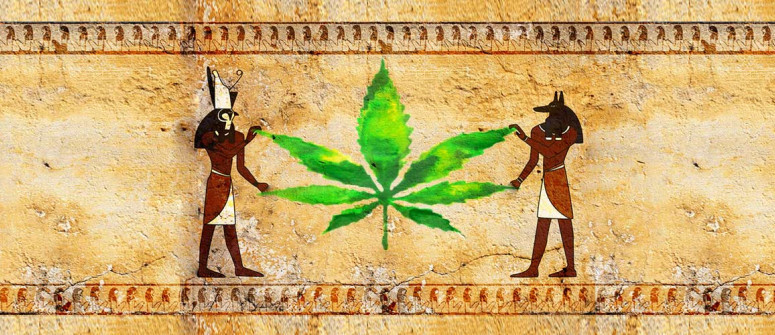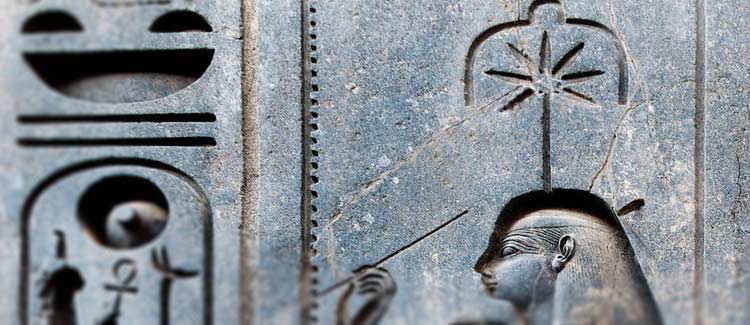Cannabis in ancient egypt

Ancient Egypt continues to amaze and astound with new archaeological discoveries and interpretations. This is the forbidden history of marijuana in the land of the Pharaohs.
Cannabis has been used throughout human civilization across the globe. Its use spans back millennia. One such civilization was ancient Egypt, and while it is seen as a controversial subject, there is more and more evidence surfacing showing how cannabis was utilized by this ancient society.
We take a look at some of the findings that suggest how weed was used, and the interpretations academics are debating.
SESHAT: GODDESS OF WISDOM, KNOWLEDGE, WRITING AND PROBABLY WEED

Hieroglyphics can be complicated to interpret correctly. However, the depictions of the ancient Egyptian Goddess Seshat prominently feature a weed leaf above the deities head. It’s pretty hard to miss really.[1]
Moreover, the stem from the base of the 7 finger cannabis leaf connects to the head of Seshat. Clearly symbolizing the link between cannabis use and consciousness expansion by joining the pineal gland to the marijuana leaf via the stem.
Seshat was known as the goddess of wisdom, knowledge and writing amongst other things. Pharaoh Tuthmosis III (1479 to 1425 BC) referred to her as “she of the seven points”. While the Coffin Texts, a collection of funeral spells painted on the walls of the sarcophagus of middle Kingdom Pharaohs, reveal her psychoactive power. According to spell 10 “Seshat opens the door of heaven for you”.
THE FIRST FARMERS
Most of the land of modern Egypt is not suited to agriculture; in fact, less than 3% is good farmland. Thousands of years ago this was not the case and the area was more like an Egyptian Garden of Eden. In the ancient past known as the pre-dynastic period — somewhere between 6500-5000BC — the first farmers began raising crops in the Nile Delta region.
The paleoclimatic history of the river Nile and the rise and fall of the dynasty of the Pharaohs are interconnected. A prolonged drought could lead to cannibalism in the days of antiquity.
We know that during the first dynasty, circa 3000 BC, the Egyptians were already using sluice gates to control flooding and draining of farmland. From the perspective of the contemporary outdoor cannabis cultivator, ancient Egypt was a great spot to grow weed. Plenty of sunshine, warm weather, and a big river.
The Nile alone provided a fresh water source and fertilized the soil. Plus the Nile tilapia fish is a native species most suited to Aquaponics.
MUMMIES TESTING POSITIVE

Dr. Svetlana Balabanova, toxicologist and endocrinologist at the Institute of Forensic Medicine in Ulm Germany, shocked Egyptology and the World in 1992 when she performed drug testing on 3,000-year-old mummies.
Positive tests results for THC, cocaine, and nicotine stirred a controversy that has still not been settled. Ancient cannabis use was taboo enough without tossing in New World drugs.
Follow on research of mummies dated to 950 BC published in 1994 by Parsche and Nerlich confirmed the positive THC results. Concluding that the Egyptians habitually toked up.[2]
“The observation of significant concentrations of tetrahydrocannabinol which represents the psychoactive substance of drugs as in hashish in the lungs with values above those of the other internal organs, argue for a preferential incorporation of this substance by inhalation”. Recreational use rather than exclusively ritual use can be surmised.
PROOF ON PAPYRUS
Medical cannabis recipes and remedies can be found in several ancient Egyptian medical texts such as Ramesseum III Papyrus (1700 BC), Eber’s Papyrus (1600 BC), the Berlin Papyrus (1300 BC), and the Chester Beatty VI Papyrus (1300 BC). The Eber’s Papyrus is the most comprehensive ancient medical pharmacopeia, which includes a recipe for a cannabis and honey vaginal suppository believed to aid childbirth. The Ramesseum III Papyrus refers to a cannabis eyewash to treat glaucoma.[3]
So as you can see, while archeological evidence is only just establishing use, it is evident that cannabis played a large role in ancient Egypt. Who knows what future discoveries may find?
Knowing this, don’t think you can just go and smoke some weed in nowadays Egypt, as unfortunately, cannabis is highly illegal.




